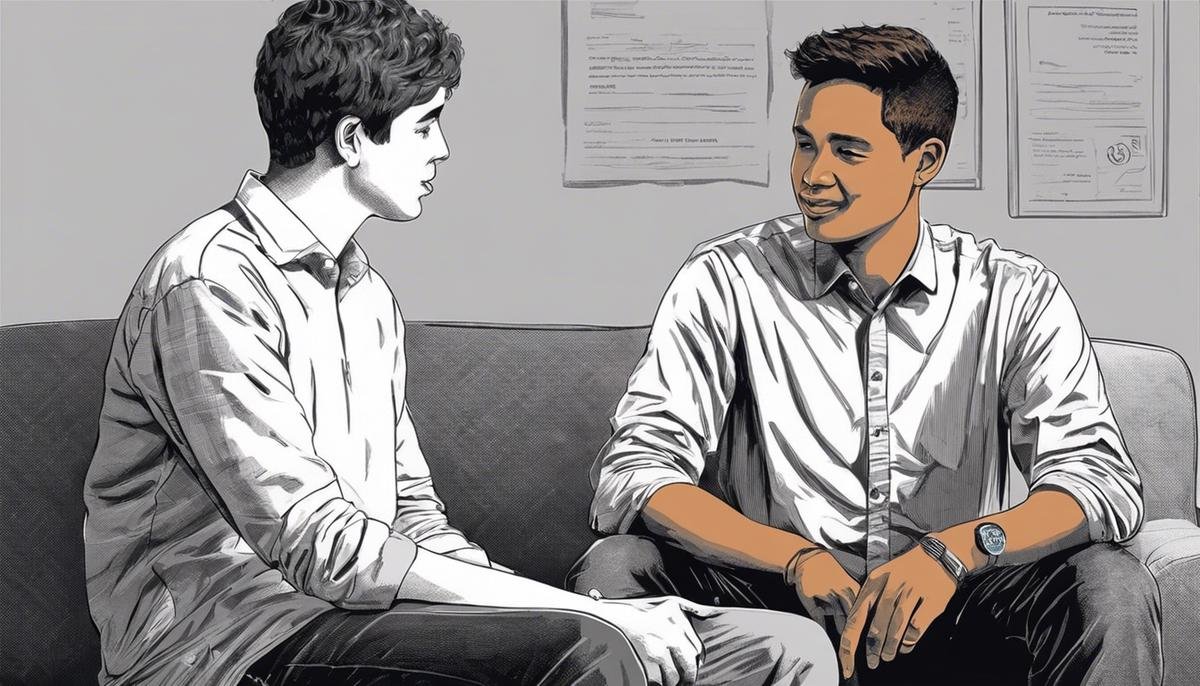
In navigating through the multifaceted world of Neurodiversity, it is vital to comprehend and respect the unique experiences of individuals with Autism. Often, undue misconceptions and harmful stereotypes undermine the genuine understanding of Autism, a neurodevelopmental disorder with varying degrees of manifestation. Clinical definitions and labels, although necessary to some extent, cannot wholly represent the individual experiences, feelings, and challenges faced by Autistic people. Therefore, we delve into recognizing the nature of Autism and how it impacts the social, emotional, and physical realms of their lives. This journey of understanding is the entry point in fostering empathetic and respectful interactions.
Understanding Autism
Understanding Autism: A Closer Look at Its Impact on Individuals
Autism, or Autism Spectrum Disorder (ASD), is a complex developmental condition that comes with a range of conditions. These conditions can affect each individual differently, making it a truly unique journey for every family. Especially relevant for parents with young children, understanding Autism is a crucial part of nurturing and supporting children’s well-being.
Characterized by difficulties with social interaction, communication, and repetitive behaviors, Autism is not just a singular condition. It’s sometimes associated with distinctive strengths and differences too. This broad “spectrum” means some may need a significant amount of support in their daily lives, while others might require less assistance and, in some cases, live entirely independently.
Some signs of Autism can appear in the early developmental stages, often being noticeable within the first two years. It’s essential to observe interactions and recognize signs, like avoiding eye contact, difficulty understanding feelings, having intense interests, repetitive behavior, or sensory sensitivities. But remember, every child is unique, and these signs might vary greatly.
Now, let’s delve into how Autism can affect individuals. Primarily, social interaction and communication challenges stand as noticeable hurdles. Conversing with others, expressing emotions, or understanding others’ feelings can seem a complex maze for those on the spectrum. It’s not that they’re incapable of emotion or empathy; rather, they have their distinctive way of processing the world.
As parents, it’s fundamental to maintain a growth mindset rather than viewing Autism as a barrier. Encouragement and a positive environment can help a child on the spectrum to develop skills and eventually overcome these challenges.
In addition, catering to the sensory sensitivities that come with Autism also plays a paramount part. These individuals often experience over or under sensitivity to sights, sounds, touch, tastes, or smells. Consequently, managing these sensitivities with a balanced routine and a comfortable environment at home can mean a world of difference in maximizing their potential.
Lastly, remember, a diagnosis of Autism doesn’t define the individual; it just offers a better understanding of their needed support and effort. Despite all challenges, persons with Autism can excel in different areas, whether it’s music, art, math, or memory tasks. They can learn, grow, and succeed -just like any one of us!
Autism is part of a profound, unique spectrum, with each individual having their own strengths and challenges. Understanding this, showing compassion, and providing appropriate support goes a long way in making lives better for those on the spectrum. Let’s celebrate these unique individuals, ensuring they feel loved, supported, and understood in our families and our communities.

Common Misconceptions and Stereotypes about Autism
Unraveling the Stereotypes: Shattering Autism Misconceptions
People with Autism Spectrum Disorder (ASD) often find themselves at the receiving end of several stereotypes and misconceptions. While it’s true that this disorder carries its own set of unique challenges, it’s crucial to recognize the harmful effects of these mistaken beliefs, as they form barriers in understanding and supporting this incredible community.
One common myth about those with autism is that they lack the ability to emote or show affection. The truth is, individuals with ASD express emotions and care in their unique ways. The difference lies in the mode of expression, not in the capacity to love or form emotional bonds. Each person with autism has their unique way of showing affection, which may not align with conventional norms but is equally valid and heartfelt.
Another prevailing misconception is that all individuals with autism possess savant or superhuman skills, as seen in movies like ‘Rain Man.’ Unfortunately, this generalization is misleading. While it’s true that some on the spectrum might harbor specific heightened skills, it’s not a universal trait and varies widely among different individuals.
Moreover, the broad brushstroke of labeling all those with ASD as ‘socially awkward’ is a major stereotype. The truth is, autism shows a spectrum of symptoms and not everyone on the spectrum experiences social difficulties to the same extent. Many individuals with ASD desire social interaction and can cultivate meaningful relationships with appropriate support and understanding.
Similarly, the notion that people with Autism Spectrum Disorder prefer solitude and cannot form social connections is another damaging stereotype. Individuals with autism may sometimes need their personal space, just like anyone else, but it doesn’t equate to a life of solitude. They, too, enjoy the company of others and can savor the sweetness of connections.
A common misconception that further traps individuals with ASD is the belief they can’t lead a fulfilling life or be independent. With the right support, a well-constructed environment around their needs and strengths, and ample opportunities to foster their potential, individuals with autism can lead fulfilling, independent lives.
It’s also erroneous and unfair to equate autism with intellectual disability. Cognitive abilities in individuals with ASD show tremendous variability, with many demonstrating average to high intelligence levels.
Lastly, it’s essential to remember that not all individuals on the spectrum display the same behaviors or symptoms. Each individual with ASD is unique, bringing their special combination of strengths, abilities, and challenges to the table. Therefore, applying the same rule or strategy to all is ineffective and may even prove harmful.
Through gentle and mindful strides towards understanding Autism Spectrum Disorder and debunking its mistaken beliefs, we lay the foundation for a more inclusive and accepting world. Remember, by seeing beyond stereotypes and misconceptions, we allow for the unique abilities and strengths of individuals with ASD to shine through and enrich our lives in the most delightful ways.

Avoid these: Statements and Questions that can hurt
Continuing on with a deeper understanding of Autism Spectrum Disorder (ASD), it’s vital to understand that while the journey of understanding can be challenging at times, it’s imperative to always be mindful of the kind of language used around those living with autism. Certain expressions or questions, though well-intended, can hurt or alienate someone with autism. Here are a few examples and recommendations on how to adjust our language for greater inclusiveness.
The phrase “You don’t look like you have autism.” might sound innocent on the surface but is often considered as invalidating the individual’s experience. It operates under the inaccurate assumption that autism has a certain ‘look’, which is incorrect. Autism is a neurological condition and does not physically manifest in a person’s physical appearance. Instead, ‘I’m interested in learning more about your experiences with autism.‘ shows curiosity without being presumptuous or dismissive.
Another common expression is, “Everyone’s a little autistic, right?” This statement dangerously minimizes the lived experiences of those with autism. It equates the challenges that come with autism to commonplace quirks or habits in a way that trivializes the diagnosis. Instead of dismissing the diagnosis, it’s more compassionate to recognize the legitimacy of autism as a neurological difference by simply stating, ‘Your experience is unique to you.‘
“People with autism are so honest, regardless of people’s feelings.” This statement is harmful as it inaccurately generalizes that people with autism are blunt or insensitive. In reality, each person with autism, like neurotypical individuals, varies in their ability to perceive and navigate social situations. Refined communication like, ‘Everyone has a unique way of expressing themselves.‘ is more considerate and affirmative.
Coming across as dismissive, phrases like, “Why does that bother you? It’s just a sound/light/touch!,” neglect to recognize the sensory sensitivities that many individuals with autism experience. A more empathetic approach might be to ask, ‘How can I make you more comfortable?‘ or simply acknowledge, ‘That seems to be bothering you, let’s see how we can make it better.‘
Lastl, the refrain “I’m sorry.” often comes up after hearing about an autism diagnosis. But this statement positions autism as a tragedy or something negative, when in fact, many individuals with autism and their families view autism as simply a part of their identity—not something to mourn. More appropriate would be, ‘Thank you for sharing that with me.‘ or, ‘It’s wonderful that we have a better understanding of each other now.‘
Remember, language is powerful and the words we use shape the world around us. It’s time we make our world a little warmer and more inclusive by being mindful of how we talk about autism. Let’s replace hurtful and dismissive phrases with understanding, acceptance, and empathy.

Constructive Communication with Autistic Individuals
Creating a Comfortable and Compassionate Conversation – How to Communicate Effectively and Kindly with Someone on the Autism Spectrum
Autism is not a one-size-fits-all condition. Consequently, communicating effectively with someone on the autism spectrum requires an understanding of their unique traits, preferences, and boundaries. With the right mindset and strategies, conversations can be a source of connection and mutual understanding.
One of the most effective ways to connect with someone with autism is through clear and concise language. Individuals on the spectrum often process information literally. Therefore, saying exactly what you mean can help avoid confusion and misunderstandings. An abstract phrase like “it’s raining cats and dogs” might be taken at face value, causing avoidable confusion. So, it’s teachings such as these that everyone should remember in practice.
Consistency in action and words can also be beneficial since change and unpredictability can be unsettling for people with autism. As a family member, teacher, or friend, demonstrating consistency can provide a sense of security. It’s as simple as regularly saying goodnight at the usual time or maintaining the routine of a morning greeting. Keeping routines predictable, honoring established rules, and respecting routines are small, yet very impactful actions which foster effective communication.
Being patient and giving individuals with autism the time they need to respond is another approach that goes a long way. Sometimes, a little more time is needed to process information or form a reply. Understanding this difference and fostering a relaxed conversational pace can make communication much more comfortable.
Visual aids can also be a useful tool. Visual schedules, charts, or images can be a great assistance in facilitating understanding. For instance, a visual schedule can help make the day’s plan clear and predictable. It fosters self-reliance and acts as a security net against abrupt changes during the day.
It’s also crucial to respect sensory sensitivities during conversations. The environment in which the conversation takes place can contribute a good or bad outcome. A calm, quiet environment with soft lighting might be more comfortable than a location with lots of noise, bright lights, or busy visuals.
Foremost, it’s important to listen, whether it’s a verbal conversation or non-verbal cues. Listening is critical to comprehension and ultimately, forming respectful relationships. An action as simple as recognizing and honoring a request for a conversation break can make all the difference.
Finally, remember to show empathy. Validation of feelings and experiences can go a long way in developing trust. Let’s shift from viewing those with autism as ‘other’ and begin to see through their perspective – a perspective that is shaped by unique and valuable experiences.
In conclusion, effective communication with people on the autism spectrum is all about understanding, respect, and empathy. It’s about recognizing what they have to say, matching their communication style, and offering unconditional acceptance. Kind words, patience, and a genuine attempt to comprehend their viewpoint, can help in bridging the gap and nurturing meaningful relationships. And, in fact, isn’t that what we all seek in our interactions – to be understood, respected, and cherished for who we are? Indeed, thoughtful and kind communication does not just benefit individuals with autism; it enriches all our lives.

By arming ourselves with a sound understanding of Autism, debunking prevalent misbeliefs, and learning to communicate in nurturing manners, we can significantly enhance the lives of Autistic individuals. The capacity to respect and value their place in the world is contingent on empathy – it begins by recognizing that our words can unknowingly reflect ignorance, leading to inadvertent harm. We have the ability to reshape our language, our actions, and our thinking – all of which can contribute to a more inclusive and accepting society. The heart of this message is that every individual, Autistic or not, has unique potential and worth that should be appreciated, and a right to be treated with respect and kindness, which should never be overlooked.




